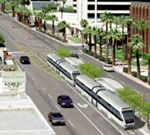
Light Rail Progress can be contacted at: Light Rail Progress |
Since 2000, when voters approved a critical transportation funding
measure, the Phoenix area has had a major light rail transit (LRT)
project under way. The initial 20.3-mile (32.7-km) line is planned
to extend from north central Phoenix, down Central Avenue
through downtown Phoenix, along Washington St., across the Salt
River, through the close-in suburban city of Tempe, and into a
southeastern terminus in downtown Mesa, another suburb. (See
map, below.) Under the current schedule, it's expected to open in
2008. Starter line: 27,000 trips a day expected The line is routed almost entirely in existing major arterial streets and roads (except for a section on viaduct, and a short stretch on an abandoned railroad branch line past the campus of Arizona State University). Estimated to cost approximately US $1.3 billion, or abount $65 million per mile ($40 million/km), the LRT starter system is expected to be completed and opened for operation in December 2008. Valley Metro, the public agency in charge of the project, forecasts that ridership will reach about 27,000 rider-trips per day. Those are trips that will be made out of the congested traffic stream and which won't compete for scarce parking.
Major expansion facing voters As the project has gained momentum, other Phoenix-area neighborhoods and surrounding communities such as Glendale have expressed interest in getting connected into the LRT system. Responding to this enthusiasm, officials have included LRT expansion in Proposition 400, a transportation-funding ballot initiative coming before voters on Nov. 2nd. Prop. 400 would extend the current half-cent sales tax in order to fund the expansion of LRT and the overall transit system, as well as to expand the area's roadway system. In fact, of the total $15.8 billion plan up for approval, 57% is dedicated to building new freeways and expanding existing roadways. Less than 15% would go to LRT expansion - yet that has been the major focus of pro-highways transit opponents. All told, Proposition 400 would fund a massive expansion of LRT in the Phoenix area: 27 miles (43.5 km) of light rail, mostly in Phoenix (see map, below). Six extensions are included: · 2 miles (3.2 km) south along Rural Road in Tempe, from the main line on Apache Boulevard · 2.7 miles (4.4 km) on Main Street in Mesa from the former Tri-City Mall to downtown · 12 miles (19.4 km) from central Phoenix to Paradise Valley Mall along state Route 51 · 5 miles (8.1 km) from 19th Avenue in Phoenix to downtown Glendale · 5 miles (8.1 km) from 19th Avenue in Phoenix to Metro Center mall • 11 miles (17.7 km) along I-10 in the West Valley to 79th Avenue Prop. 400 would also fund additional park & ride facilities at new
stations on the expanded LRT system. While polls initially suggested strong public support for the project and the ballot measure, critics have seized on a $100-million increase in the earlier cost estimate, and a projected prolongation of the project by two years, to strengthen a concerted anti-transit crusade with its familiar barrage of misinformation. However, the additional costs and the time extension are mainly the result of design changes responding to community concerns with aesthetic modifications. Reducing congested roadways 38-48% Much of the opposition has centered on the now-familiar red
herring of rail critics that the LRT system will have no impact on
regional congestion. However, Valley Metro, in project documents
filed with the federal government, calculates that the LRT system
will reduce traffic congestion significantly – in fact, LRT is
projected to reduce the number of congested roadways during the
morning peak hours by 38 percent, and by 48 percent in the
afternoon peak periods. Valley Metro's computer modelling also
predicts significant annual travel time savings of up to 585 hours
per year "for many Valley residents living near the planned light
rail route – as well as those living as many as 15 miles away." And Valley Metro and Phoenix-area community planners have identified even more new corridors for possible future light rail extensions, including routes in the suburbs of Tempe and Scottsdale. "With our population expected to double to nearly 6 million people in twenty years, Proposition 400 is the balanced and integrated transportation solution we need to keep moving in the right direction" emphasizes the Yes on 400 campaign. For further information: NOTE: Much of this report has been adapted from material disseminated by the Public Transport Progress news distribution list.
Light Rail Now! website Updated 2004/10/30 |
|
|
|